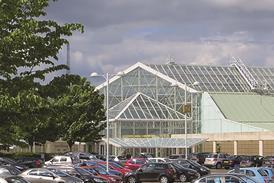Have you ever thought about the height of the shelves in your office kitchen? Where the main entrance is – or how well it’s lit? How about the amenities around your office: not just the places to grab a sandwich or take clients for a drink, but also the nursery and the dry cleaner?

There’s no right or wrong answer – but the real estate industry needs to make sure that these questions, and many more like them, are on the agenda.
Is it embedding gender equity in commercial real estate design? From design, development and operations, is it doing enough to make sure workplaces truly work – for everyone?
There is a wealth of ways in which the office may not work for women. From glass staircases to thermostats set to uncomfortable temperatures (according to a 2015 study in Nature Climate Change women prefer an office temperature of 24°C while men prefer 21°C), gender equity is too often neither considered in the design nor in the running of where we spend our working lives.
This has obvious implications: colleagues will not be their most productive and creative in spaces that feel uncomfortable at best and unwelcoming at worst. They will not have the same opportunities to progress in their careers if they are excluded – 49% of women leaders say flexibility is one of their top priorities when joining or staying in a company, compared with 34% of men leaders, according to McKinsey and Lean In research from 2022.
What this presents is a huge opportunity for the real estate industry. The chance to be seen to be creating workplaces for women – as well as men – amid a continued drive to differentiate, stand out and attract occupiers (and investors) who want environmental, social and governance-enabled workspaces that make a positive social impact.
For clients wanting to stand out in a crowded field, our advice is pretty consistent: be authentic. When you identify your purpose as a business, you’ll be on to a winner.
Social impact is increasingly ratcheting up the agenda, driven by recent announcements from the likes of British Land and Landsec.
But that does not mean social impact needs be the preserve of the big beasts (as great as it is to see leadership from these firms). It can be something that a property company of any size does, simply by being authentic to its purpose.
Landsec’s social impact strategy is focusing on the diversity of its own workforce, and therefore, given its size, the industry’s as a whole. Its success on this will be closely watched and could become a blueprint for how we as a sector embrace diversity within our organisations.
But another tangible and authentic way that the likes of Landsec, or British Land, or any other developer, can make a positive social impact through embedding gender equity in the workplace is through truly authentic community engagement.
The first principle of social value is engaging with those who will be affected by the changes your decision is going to bring. Fortunately, for developers, you’re already very well placed: consultation and engagement is something you do, day in, day out.
When designing and developing a workspace, ask for other people’s perspectives and you might be surprised what they say. Engage meaningfully – at little or no cost – to gather better ideas and insights to shape vastly better places.
For regeneration projects it’s straightforward: you consult the community about what they want, need and hope for from a rejuvenated physical environment. For an office developer, the principle is the same. If you have a pre-let, ask your future occupier and its team what they want and need; if you don’t, you can even ask your own employees.
When SEC Newgate moved into our offices at the start of 2022, the space that our team moved into was a space designed around their wants and needs. And, 18 months in, we’re still asking and we’re still adapting to make sure that the space works. That’s why we have designated zones for quieter and collaborative working, why we placed such a premium on natural light, why we’ve made provision for everything from podcast studios to breastfeeding rooms – because we asked the team what they needed to do their best work.
A large part of how we create a more gender-equitable built environment is by becoming a more gender-equal industry. However, while we continue to make impressive strides towards that – strides that so many in the industry should be proud of advocating for – we can begin to make a difference today.
Whether it’s in design, development or operations, the path to gender equity in commercial real estate is through engaging meaningfully with all of your stakeholders.
Laura Leggetter is practice head, communications, at SEC Newgate































No comments yet